 |
||
|
||
| ||
By Maxim
Liadov
Today we are going to examine a new sound card with a CNR connector. Intel announced the CNR specification more than year and a half ago, but users who have computers with an installed motherboard on the i815 do not use this slot in 99% cases. But this slot is really a cool thing. For example, you can organize a 6-channel sound of decent quality at a small sum of money which wouldn't yield to expensive 6-channel sound cards in functionality. As an AC'97 codec is a program solution in its possibilities, everything depends on a drivers supplier. If it is Sigmatel or Avance Logic the sound will just work, and it is already good. But if it is Intel + Analog Devices you will be offered high-quality sound of DACs, plenty of utilities, full support of all Sensaura technologies, normal EAX 2.0 in games, efficiency not worse than that of hardware sound cards with a powerful DSP etc. (the detailed information can be found in the Integrated AC'97 sound on Intel D815EFV mainboard). If you like these features and you want a multichannel sound in games and normal 5.1 soundtracks in movies, you should buy a CNR card with additional two codecs and two linear-outs or even with a digital optical-out. Such extendibility will be useful not only for users but for system integrators as well: the low price, flexibility in building different computer configurations with different components (with a 2-channel sound, with a 6-channel one, with a 6-channel sound and a digital-out). As compared with usual sound cards, installation of drivers for an inexperienced user will cause much problems. For this operation to succeed even on the W98SE it is necessary to set a great deal of patches: drivers, a chipset, Microsoft Win98 SE WDM Audio Driver Patch (in course of an automatic installation of the patches and the drivers for the Intel D815EFV under the Win98SE my computer was rebooted about ten times). Another drawback is that you can upgrade only a motherboard with an Intel's chipset where the south bridge (I/O controller hub) has one of the following markings: ICH 82801AA, ICH0 82801AB, ICH2 82801BA, ICH3 82801CA, and the board must have SoundMax AD 1881, AD1885 or AD 1886 codec. Any other codec doesn't suit (I checked it on the Sigmatel STAC9721 and on the CMI8738 integrated into a mainboard). How it worksA modern audio subsystem features two main units: a digital controller and an audio codec. In case of multichannel solutions the number of codecs may vary. It is backed by the AC'97 specification from Intel which appeared yet in 1997. 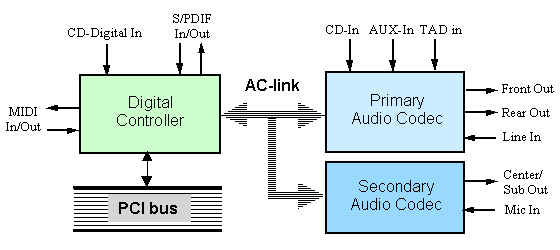 Since even the cheapest CPUs are powerful enough today for an average user, in case of the AC'97 sound a central processor fulfills all functions of a digital controller on the driver level instead of taking a only partial load of operations with audio streams as it takes place in inexpensive HSP solutions (YMF7x4, FM801AU). Data exchange with an AC'97 audio codec on the hardware level is undertaken by an ICH (I/O Controller Hub) integrated into the chipset by means of an AC-link bus controller. 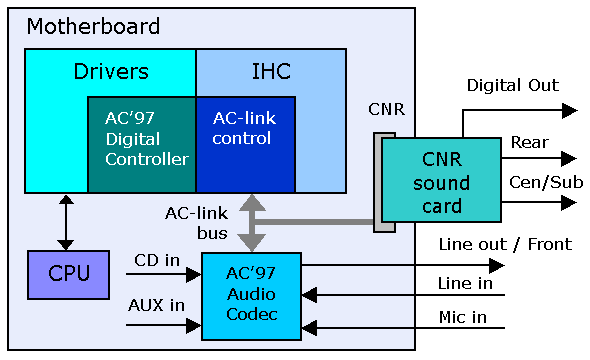 The second and third codecs or even a digital-out can be set onto a CNR card, thus, providing the flexibility and extendibility of an audio subsystem. Why are, then, budget chips so considered bad, for example, CMI8738? Well, they are not, at least, for its price niche. But the sound quality of the Analog Devices codecs is much higher, the drivers are more stable and functional, and the utilities are of better quality. Hercules SC-Riser 6 This card is meant to extend a usual stereo sound up to 6 channels. The PC99 colors imply that the card is equipped with connectors for the following speakers: rear (a black connector) and center/subwoofer (an orange connector). The card features a powerful stabilizer from ST (in the upper left-hand corner) and electrolytic capacitors which are usually installed on expensive equipment. There are also 2 stereo AC'97 audio codecs Analog Devices AD1885: 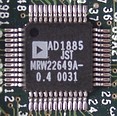 These codecs have quite good multibit SD converters, 6-bit volume controls for a fine adjustment of a signal level and an integrated matching linear buffer for headphones. Hercules SC-Core 6 Digital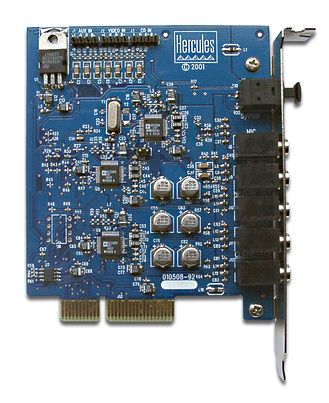 The second card in question is a 6-channel one with a digital-out. Actually we had a preproduction sample, while the production card looks much more attractive: 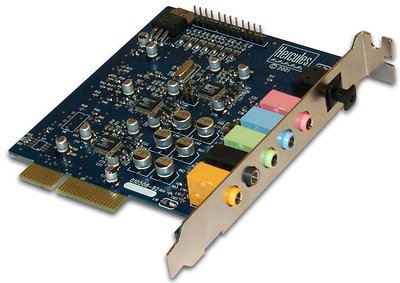 The components of better quality, the connectors are of different colors etc. By the way, it's good that connectors are metallized inside and covered with plastic: both the construction is stronger and it is clear where cables are to be put to. SoundMax3Here is an extract from the Analog Devices site's partition devoted to the SoundMAX technology. Software part:SoundMAX with SPX software from Analog Device with the driver distributing weighing 54 MBytes. Optimization for MMX and SSE2 SIMD instructions for Intel Pentium III and Pentium 4 is provided. Drivers:Win98 SE, WinME and Win2K. Compatibility with game 3D Sound APIs:
Audio codec's characteristics:
MIDI:
SPX (Sound Production eXtention) is a new generation audio rendering technology. Sound synthesis is controlled directly from games and multimedia applications. 3D sound from Sensaura:
InstallationThe cards came with a CD "for use with samples only", that is why I don't know what production cards will be supplied with, but the most important thing in software is drivers. There were quite new ones for Win98 SE, WinME and Win2K. The SoundMAX3 drivers were installed the same way as for the integrated sound of the Intel's board. When you install the Hercules SC-Riser 6 the system acquires the following devices: With the Hercules SC-Core 6 Digital the situation is the same: After rebooting the system tray gets a blue icon of Analog Devices. When you choose the upper item you will receive a control panel of the SoundMAX 3.0. For speakers there are 3 modes: headphones, close stereo speakers, far stereo speakers. For sound environment there are more than 10 presets. Virtual surround sounding is a function of creation of virtual sources in headphones or speakers. Click the image and you will be taken to the Sensaura's site into a virtual shop where you can fetch this paid upgrade version (only for the SonudMAX3!) or load a 31-day trial one: 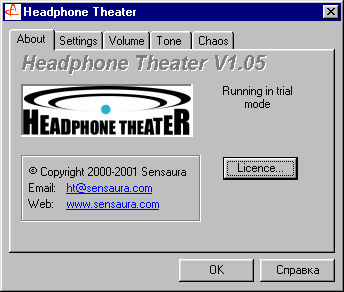 The Headphone Theater technology from Sensaura maintains positions of sources and sound's volume, doesn't distort a phase of sound or change high frequencies. The sound was interesting and much better than any extensions of stereo bases and Dolby Surrounds. There are also extended options of adjusting reverberation of a virtual auditorium where a movie is supposedly watched. 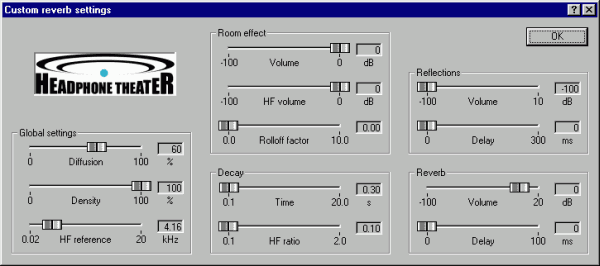 Another interesting technology is Virtual Ear (which is not free as well). There are only 3 standard presets for HRTF filters; and you can adjust a 3D audio engine for your ears. 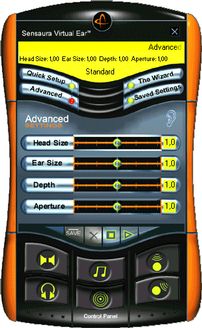 The next sheet is designed for MIDI. A wavetable synthesizer 4 MBytes DLS2, 128 GM instruments, a special loader of MIDI+DLS2 files. The drivers come with three demo files with loadable samples. 1024 MAXvoice program voices and a standard GM bank of 4 MBytes are quite acceptable. At least, it is much better than an ordinary program Microsoft DirectMusic synthesizer with 3 MBytes of GS samples Sound Canvas from Roland. 360 XGlite instruments of 1.2 MBytes are of less interest. I tried to play GM and XG compositions and found out that instruments sounded quite different than in the S-YXG50. Fans of the XG MIDI would better install a standard software wavetable synthesizer Yamaha S-YXG50 or Yamaha S-YXG100. The sound from the samples was also tested on several karaoke files. Sometimes the 4 MBytes DLS2 GM bank was better, sometimes the S-YXG50 excelled. The XGlite sounded blankly, and quality of mixing of MIDI channels wasn't high. But you will hardly notice it on some cheap equipment. Linear-out testsI'd like to stress once more such interesting features of the AD1885 codec as a multibit SD converter, a changeable AC-link bus frequency (from 7 to 48 kHz in 1 kHz steps) and a possibility of direct connection of headphones without an external operational amplifier. The tests were carried out with the RightMark Audio Analyzer 2.5. Tested chain: AD1885 Line Out - WT2496 Line In
General performance: Good (in detail) Despite the fact that we tested a sample, the AD1885 codec showed decent results. First of all, it has an excellent frequency response and THD. Just compare: 0.005% of the AD1885 and 0.055% of the competitor CMI8738. The measurements have strengthened the good impression of the sound quality when listening to MP3 and CD-DA. Tests in gamesThe Sensaura algorithms allow reaching high quality of positioning and compatibility with a wide range of game 3D Sound APIs: DirectSound/ DirectSound 3D (DirectX 8.0), EAX 1.0/2.0, A3D 1.0, Sensaura Macro FX / ZoomFX, IA-SIG I3DL2. The EAX 2.0 is completely supported. I tested its operation in DeusEX (UT engine), Hitman: Codename47, Gunman Chronicles (HL engine) and Serious Sam. There was positioning of sources and the sound was excellent and didn't disappear even on such a weak computer as P3-550/128/GF2MX. The EAX environment presets were enabled when necessary. The test benchmarks and impressions can be found in the Integrated AC'97 sound on the Intel D815EFV mainboard ConclusionThe Hercules SC-Core 6 Digital and Hercules SC-Riser 6 card have a good sound and excellent drivers. But the CNR cards do not suit all mainboards: they can work only with a board which has an Intel's chipset where the I/O controller hub has one of the following markings: ICH 82801AA, ICH0 82801AB, ICH2 82801BA, ICH3 82801CA. The board must also feature SoundMax AD 1881, AD1885 or AD 1886 codec. Highs of the Hercules Sound Cards with CNR:
Lows of the Hercules Sound Cards with CNR:
Write a comment below. No registration needed!
|
Platform · Video · Multimedia · Mobile · Other || About us & Privacy policy · Twitter · Facebook Copyright © Byrds Research & Publishing, Ltd., 1997–2011. All rights reserved. |